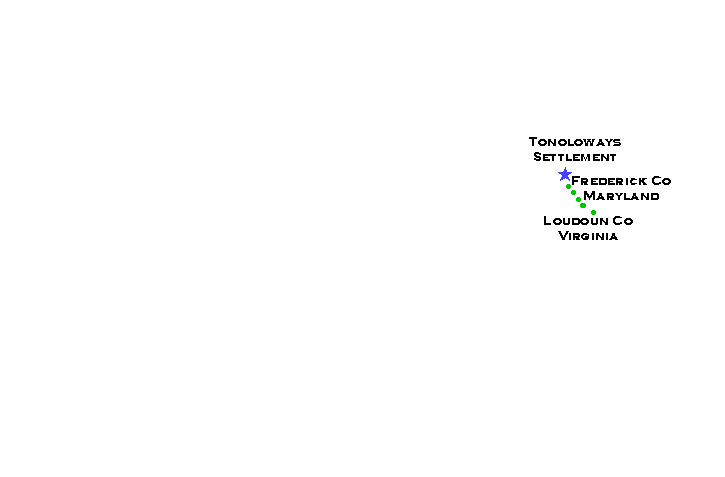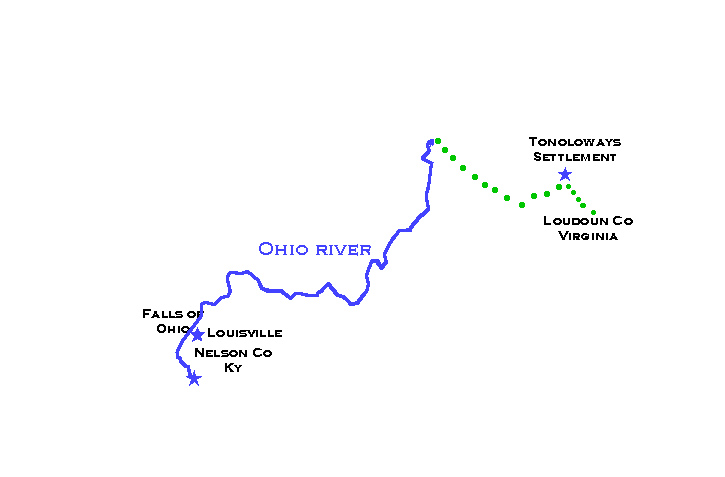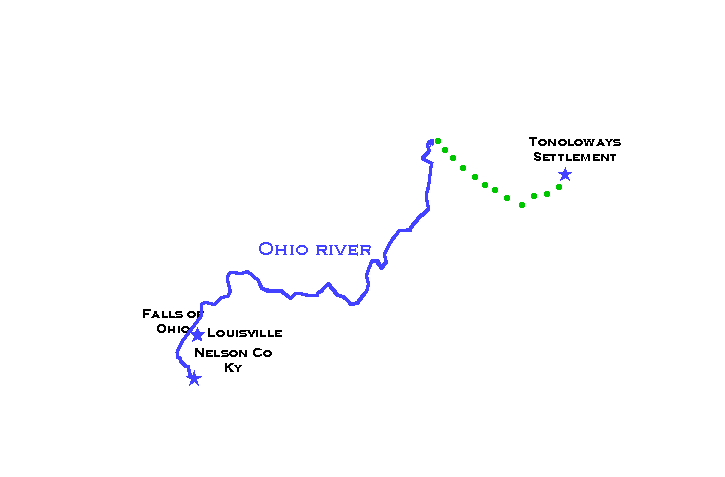SPECIAL STUDY: TONOLOWAYS SETTLEMENT
|
[ Overview | Research Goals | Study Learnings | Descendancy | Research Reports ]
| Key to Links: |
|---|
 Family history research Family history research
|
 Lineage “Snapshot” & Contact Lineage “Snapshot” & Contact
|
 DNA Findings DNA Findings
|
 Lineage Studies Lineage Studies
|
 Oral History Oral History
|
A group of COMBS-COOMBS that has been of great interest to many researchers can be found in a colonial settlement with its beginnings about 1730. Researching this settlement has been complex due to the place names ascribed to it and the ambiguity of its location within different jurisdictions. While the name of the settlement evolved over time, for the purposes of this Special Study we will refer to it as the “TONOLOWAYS SETTLEMENT”.*
During the Colonial period the Tonoloways Settlement was viewed as being in either, different territorial or county jurisdictions of Pennsylvania, or of Frederick Co., Maryland, (prior to the drawing of the Mason-Dixon line in 1766). The Settlement was considered a broad area of frontier farms (some built up into 'forts') which stretched from the Little Tonoloways Creek on the west to (Big) Tonoloways Creek on the east, and from the Potomac on the south to the mountains northward below the settlements of Big Cove & Little Cove. After Mason & Dixon finished their survey, land owners learned to which state their land belonged **. These factors need to be kept in mind while studying and drawing assumptions of COMBS-COOMBS found in this area of Colonial America.
This OVERVIEW delineates the names of the COMBS-COOMBS ancestors who are the focus of this Special Tonoloways Study. It indicates who should be the object of DNA testing and the objectives in doing so. In addition, there are COMBS-COOMBS in the vicinity of the settlement or from other COMBS branches that have been studied by researchers and are viewed as potentially connecting with this group and furthering the ancestry. These branches can be found in other parts of Pennsylvania (one linking to Somerset, a shire in England), as well as New Jersey, Maryland and Virginia. These are mentioned in the GOALS, as well, since ruling in or out these branches of COMBS &c. utilizing DNA will be very helpful in furthering the family history of the descendants of the COMBS-COOMBS found at the Tonoloways Settlement.
As DNA tests verify the relatedness of the persons focused on in this Study, we will explain this in the DNA STUDY LEARNINGS. Refer to this section from time to time to see what is being accomplished. Our first match has been made and is noted in this section of our Special Study. Also, to better grasp the persons of the Tonoloways Settlement and the vicinity, a “CHRONOLOGY AND MIGRATION PATTERNS” have been outlined and illustrated in this part of the Study.
A section for the DESCENDANCY of these branches of COMBS-COOMBS is under development at this time. The assistance of descendants of this COMBS &c. branch is requested to build this picture of the relatedness of COMBS.
RESEARCH REPORTS about persons and localities are set up as links back into the research project to learn more and continue your study of this group of COMBS-COOMBS.
Thanks to the contributions of COMBS &c. researchers Bob COMBS, Dale Larson, Thom Montgomery, Jane McCann Walsh, Mary Golding, and others, as well as those persons who provided records to our RESEARCH PROJECT and lineages to our VIRTUAL ARCHIVE from which much of this information in the Special Study has been derived.
* Terms used to identify this area or the creek nearby the settlement are as follows: (1743) Konolowa, (after 1749/50) Conoloway(s), Tonoloway(s), Conoloways Lick, Tanolaways Crick, Big and Little Tonoloway Creeks.
** Locations associated with the Tonoloways Settlement -- Chester, Lancaster, Cumberland, Bedford, Franklin, Fulton Co's PA; Frederick and Washington Co's, MD; Berkeley and Frederick Co's, VA; Berkeley and Morgan Co's WV; & the Six Nations Indians Confederation.
As you read the research GOALS that can be accomplished by DNA testing, depending on your familiarity with the Tonoloways Settlement and the COMBS-COOMBS who resided there, you may find it helpful to refer back to our family history research project and bring your thoughts up on our COMBS &c. e-mail discussion list.
Joseph COOMBS (the elder), is the progenitor of Andrew, Samuel, John, Joseph II and Edward COMBS-COOMBS found at the Tonoloways Settlement. (This does not assume he or his issue only resided at the Tonoloways Settlement. There may also be other branches of COMBS-COOMBS present at the settlement or in the vicinity. The main factors for assuming a “Joseph” as the progenitor of this family are -- the naming of male children “Joseph” by Andrew, John, and Joseph II; the presence of 2-3 “Joseph”s in the Tonoloways area in a timeframe that would allow for at least one to be a generation earlier and therefore old enough to be a progenitor; and, the initial appearance on the earliest petition record dated 1749/50 signed by Joseph and Andrew, with the Joseph I and II, Samuel, and John appearing in a 2nd petition 5 yrs later, possibly indicative of Joseph and Andrew as being the eldest.)
Other scenarios should not be overlooked since Joseph and Andrew could be brothers; there could be more than one branch of COMBS, as well. For instance, the 1st petition spells Joseph as a COOMBE, and Andrew as COOMBS, and on the 2nd petition both Joseph's and John are COOMBE, while Samuel is COOMBES. While these could be transcription errors, this could also be significant.
By comparing “genetic profiles”, establish the relatedness of the following who have ties to the Tonoloways Settlement, and have been considered by some researchers to be brothers, and the son of Joseph COOMBS (the elder):
- Andrew I, b pre-1728; d 1774, Loudoun Co, VA; m pre-1752, Mary (CLEMENTS?), b pre 1738, d aft 1800, probably in Loudoun Co, VA.
- Samuel I, b ca 1728, d ca 1815, Nelson Co, KY; m1 pre-1760, Mary WILKES (or CHESTNUT?), b ca 1733, d pre-1791; m2 by 1791, Mrs. Elizabeth WILLIAMS.
- Joseph II, b ca 1728, d 1803, Georges Twp., Fayette Co, PA; m pre-1754, possibly to Ann (may have had more than one marriage) who may have been a BAYLIS or a DAVENPORT.
- John I, b 1730-1736, d 1801, Nelson Co, KY; m pre-1760, Alice JOLLY, b pre-1747, d aft 1801.
- Edward I, b abt 1736, d Dec 1820, Nelson Co, KY; m pre-1763, Rebecca STILLWELL (d/o Elias and Meriam EDDY Stillwell), b abt 1744, d 25 Dec 1836, Nelson Co, KY.
[These goals are considered dynamic and therefore may change as we find answers to our questions or come upon new dilemmas to solve.]
Note: New findings have yet to be added to this report. See Virtual Archive for DNA matches within this group.
DNA tests have proven the DNA “genetic profiles” of John COOMBS
&
, Andrew COMBS
&
and Edward COOMBS
,
&
noted above are related and share the same ancestry.
Their combined lineages now represent a “lineage genetic profile” that can be the basis for comparison of DNA test findings in determining whether or not researchers share the same ancestry.
Our first descendant to have been connected to this group using DNA, for which specific ancestry is unknown, is Denman J. COOMBS of Boone Co, Indiana
. John Newton COOMBS of Boone Co., IN
, also has the same situation. A relationship between Denman and John Newton is being explored further. Due to the migration pattern of John, Edward, and a Samuel COOMBS to Nelson Co, KY in the late 1700s, and given what we know at this point in time, it is likely that Denman’s ancestry is connected to one of these branches of this group of COMBS-COOMBS. The migration patterns of John, Edward and Samuel’s descendants also need to be considered here for establishing relationships over different generations. A single mutation in the DNA of Denman may be the key to distinguishing the different descendants of John, Edward and Samuel. This can be understood by comparing the DNA of more descendants of these three and seeing if a specific branch appears to have or not have this mutation. (Mutations are changes in DNA that can appear over a number of generations. They can help us define lineages and see the likelihood of relationships as well.) John Newton Coombs does NOT have this mutation and therefore further testing is needed to see where the mutation occurred.
Three lines have been identified for branches that need to be connected to the earliest ancestor and his sons. These are in VA and Perry Co, OH
; Hampshire Co, WV
; and TX and Douglas Co, WV
. The Hampshire Co, WV test has a distinct mutation unrelated to all the other person's tested. Since four of the five assumed sons of Joseph Coombe I have had descendants with DNA test results in our study, it is possible this is a descendant of Joseph II for whom we have not had an identified descendant descendant participate in the study yet. This could be a mutation specific to the Joseph II branch and needs to be determined.
Samuel COOMBS is noted in the will of Andrew as being his brother, and Edward COOMBE of Nelson Co., KY stated in a deposition that John COOMBS is his brother. Therefore should descendants be tested, Samuel and Edward should have similar “genetic profiles” if the lineages are properly documented and identities are correct, however, this remains to be proven by DNA, although documented otherwise.
Male COMBS-COOMBS descendants bearing the COMBS-COOMBS surname of the lineages noted are needed to further establish relationships and confirm research assumptions based on traditional family history. Contact the Project Administrator if you have questions about DNA Testing.
CHRONOLOGY & MIGRATION PATTERNS
See the chronology and migration patterns, by putting your cursor over the name.





This section is a “work in progress” and illustrates the branches of the families that descend from Tonoloways Settlement COMBS-COOMBS. Researchers who descend from this lineage, who would like to assist in building or contributing to this “descendancy” should write to the Project Administrator to share their branch information.
The primary purpose for illustrating the “descendancy” is so researchers can see family relationships supported by both well documented family history research and matched DNA “genetic profiles”. When you review the “descendancy” you should see opportunities for linking your COMBS ancestry to specific branches of this COMBS-COOMBS group. The design of the “descendancy” is not intended to provide all family history details like one would find in a Gedcom. Instead, the focus is on providing a simple visual tool for grasping the branches of this group of COMBS-COOMBS. Details should be searched further and are available in the Research Project, and the DNA STUDY, particularly the Virtual Archive and DNA Findings. Your research can be accomplished through electronic links placed throughout our Study.
Please click on the DESCENDANCY link to study this lineage further.
Web Pages Associated With the Tonoloways | |
|---|---|
| Coombs Fort of the Tonoloways Settlement of Maryland and Pennsylvania Joseph COOMBS I Andrew, Samuel, Joseph II, Edward, John | Report |
| Samuel Combs I of Tonoloway (son of Joseph Combs I of Tonoloways) | Report |
| Andrew Combs of Tonoloways (son of Joseph Coombs I of Tonoloways?) | Report |
| Joseph Combs II of Tonoloways (son of Joseph Combs I of Tonoloways) | Report |
| John Combs I of Tonoloways (son of Joseph Combs I of Tonoloways?) | Report |
| Edward & Rebecca Stillwell Combs I of Tonoloways (son of Joseph Combs I of Tonoloways?) | Report |
| Early Combs &c. Families of Loudoun Co, VA | Records |
| Combs &c. Families of Cumberland Co, PA | Records |
| Combs &c. Families of Bedford Co, PA | Records |
| Combs &c. Families of Fayette Co, PA | Records |
| Combs &c. Families Frederick Co, MD | Records |
| Combs &c. Families Boone Co, IN | Records |
We would like to encourage discussion about this Special Study on our Combs &c. Mailing List. And send your questions about DNA to the Project Administrator.
Thank you.